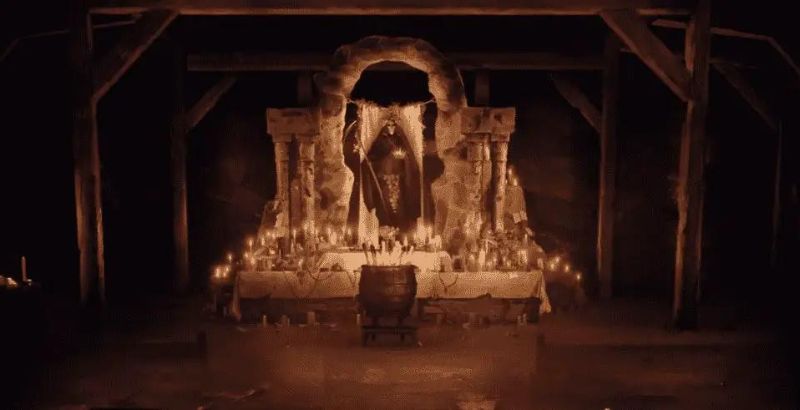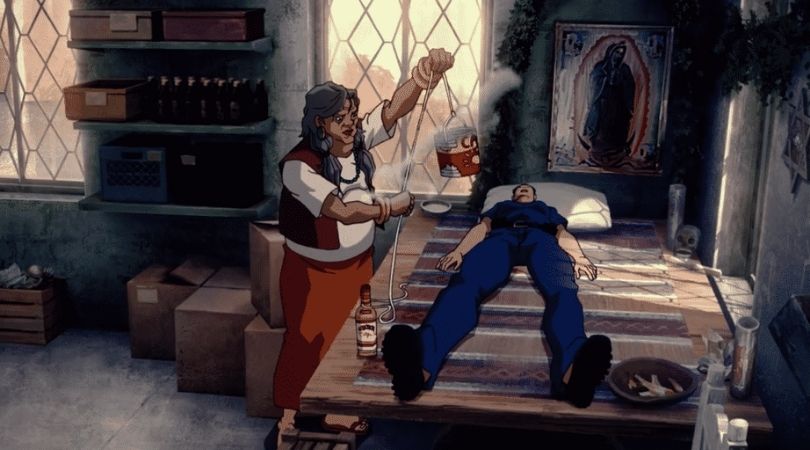
I have two degrees in religious studies and anthropology. When I entered my PhD program, it was to explore how pop culture represents and explores religious identities. Now that I’ve been out of grad school for two years, I rarely have the time or the material to explore religious expressions in pop culture. And then, Netflix released Seis Manos which explored magic and religion through the lens of grindhouse cinema. While the new anime series from Powerhouse animation is a blend of grindhouse and Kung Fu cinema, it also has a story that is tied together with Mexican folk religion and magic. Featuring curanderismo, the practice of healing, it’s the allusions to Santa Muerte that really takes you into the heart of both narco-cinema and the ways that folk traditions blend with Catholicism, often to push the latter out completely.
If you’re unaware of what Santa Muerte is, or only aware in so much as the boogeyman stories you hear about it from American news and media, it is, in fact, a complicated religion that surrounds the personification of death but is ultimately still grounded in Catholic traditions. Worshiped by narcos, Santa Muerte is often referred to as the patron saint of the cartels.
She is also more than that. Santa Muerte is the saint for the marginalized. Those who pray to her are poor and/or disenfranchised as well. Both the criminals who commit the violence and those who suffer from it look to her and readily accept that they leave recognized Catholicism. Meanwhile, the Catholic Church not only refuses to recognize her but works to discredit her and excommunicate her devotees as well. Turning to Santa Muerte when all fails, a folk religion is created most recognizable in the neighborhood of Tepito, a barrio in Mexico City devoted to the personification of death. Folk religion, in simplest terms, is a system of the beliefs, practices, rituals, and symbols that originate from something other than religious leadership.
When scholars of religion look at cultures, they often look to religious practices sanctioned by religious authority, but in order to fully understand the cultures being investigated folk religion must be looked at. In this case, the worship of Santa Muerte evolved from the existing practices of saint worship in Mexican Catholicism, a folk tradition in and of itself. When pushed out from the Catholic Church, worshipers maintained an identity that looks like Catholic faith while also existing outside of it.
While Seis Manos does not investigate this thoroughly, in El Balde, it paints the picture of a man focused on proving a Catholic God wrong by replacing him with the tangible Santa Nucifera. While Seis Manos does not mention her by name and focuses more on magic, it does use her likeness in the representations of Santa Nucifera, a skeleton clothed in a black robe, a scythe, and of course, flowers and candles adorning her alter and her effigy.
Created by El Balde around the magical powers of his mother, he continually uses Catholic rites and language to describe her and the cult around her. Most poignantly, he asks one of his lackeys what happens when he takes the body of Christ in his mouth during Catholic mass. The lackey responds “nothing.” Amused, El Balde responds that of course nothing happens, because Santa Nucifera is the only real power.
Replicating the Catholic rites of communion, El Balde feeds pieces of Santa Nucifero to her devotees. It changes them, granting them physical power through bodily mutation. As they consume her flesh, ash, or blood, they become crazed, shifting into monsters that only just resemble humans. They seek to eat, to hunt, and are the ultimate tools for El Balde as he moves to take the town of San Simon. While his motives are personal, there is a belief in him that he pushes on his cartel and those he wishes to rule in San Simon.
When El Balde does take control of the town, he replaces the church’s iconography with Santa Nucifera, blasting apart the crucified Jesus and installing a statue of her in the town square. When asked what to do with the church’s priest, he responds with “nail him up,” explaining that it will send a message to the townspeople how their God has failed.
It is important to note that El Balde’s Santa Nucifera is only connected to Santa Muerte in name, her design, and of course the importance she holds in the Narco culture of the show. El Balde uses Santa Nucifera to instill fear, to bring death, and to create monsters. While there are no monsters created in the real Mexico, the monsters of Santa Muerte are in fact the drug lords and their cartels that rip apart families, orphan children, and destroy any sense of safety in towns the take over.

The evil magic that Balde and Santa Nucifera represent could have easily demonized Mexican religiosity and spirituality that falls outside of Catholic preview, something done in much of Mexican media. Instead, Seis Manos uses curanderismo to represent the opposite side of folk religion, the one seeks to save and heal. Curanderismo is an art practiced by folk healers throughout Latin America, though my familiarity with the practice comes from those in my Mexican American family handing down stories of the curanderas in out families as well as the folk remedies that have survived them.
Now, Seis Manos isn’t the first piece of pop culture to include curanderismo this year, The Curse of La Llorona included a curandero as one of the main characters of the film, and recently, The Terror: Infamy used the practices to showcase Mexican ideas around the dead. That being said, Seis Manos and the magic in it, feels the most authentic, grounded by Garabina, the curandera who is all of our abuelas. Garabina’s power is focused on using hallucinogenics to meet with spirits while also being able to tap into what is hurting people’s soul, as she uses it to put Brister in his place as he ridicules her magic. While El Balde takes control of San Simon, it’s Garabina’s power that remains the only thing that scares and threatens him.
Seis Manos is ultimately a Mexican anime, that is undeniable. Showrunners made the choice to not include English subtitles for Spanish dialogue, every character is brown, the setting is Mexico, the narcos are there, but above all else, it’s the magic and spiritual identity of the series that makes it so. This element of magic and religion ties together the series through its use of grindhouse and Kung Fu cinema tropes and stylings.
For some, the stylized depictions of the religion may seem like it’s just used for atmosphere, but for me, the use of both a Santa Muerte clone and curanderismo works to ground the series. The iconography, the prayers, magic, the commentary on Catholicism all work to present a mythos in which the Seis Manos takes place, building out the world and adding to its Mexican identity.
Seis Manos is streaming exclusively on Netflix.






